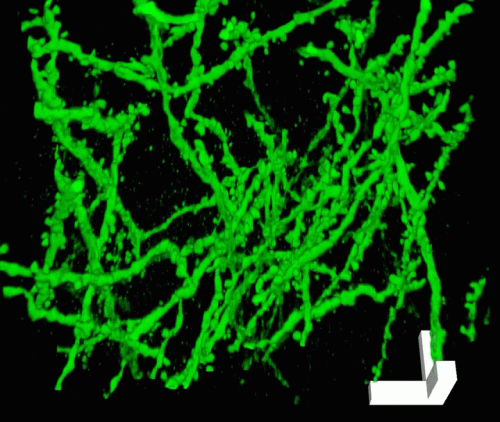Engineers enlarge brain tissue to study nanoscale features

While most efforts to understand the brain focus on new technologies to magnify small anatomical features, engineers at the MIT-based Center for Brains, Minds and Machines have found a way to make brains physically bigger.
The technique, which the researchers call expansion microscopy, uses an expandable polymer and water to swell brain tissue to about four and a half times its usual size, so that nanoscale structures once blurry appear sharp with an ordinary confocal microscope.
Expansion microscopy enables researchers to resolve details down to about 70 nanometers, while 300 nanometers was the previous limit with a conventional microscope.
Development of the novel process, which is detailed in the Jan. 15 issue of Science, was partially funded by the National Science Foundation (NSF), including support via an NSF early faculty career development award and an NSF graduate research fellowship.
The Center for Brains, Minds and Machines is an NSF science and technology center funded in 2013 as part of NSF's continuing support for the advancement of fundamental brain research.
"This clever technique, which bypasses the limitations of traditional techniques for brain imaging, has the potential to be a powerful new tool to help researchers map and understand the brain," said Pramod Khargonekar, NSF assistant director for the Engineering Directorate, which supports an array of neuroengineering projects. "It just goes to show that significant steps forward in science can emerge from unexpected and wonderful ideas."
The new method is another advance in brain imaging that brings researchers closer to illuminating the entire brain and nervous system, one of today's greatest engineering challenges.
The engineers who developed the technique, Fei Chen, Paul Tillberg and Edward Boyden at MIT, assert it offers the ability to image large, intact, 3-D brain structures with nanoscale precision for the first time.
"Expansion microscopy may provide a key tool for comprehensive, precise, circuit-wide, brain mapping," Boyden said. The team has demonstrated the process on mouse, fruit fly and zebrafish brains and is working with another team to apply it to human tissue.
Boyden adds that the process may be useful beyond the brain to other parts of the body. Many types of biological processes involve nanoscale interactions across large systems, such as cancer metastasis and immunological responses.
More information: phys.org/news/2015-01-team-enl … -samples-easier.html




















